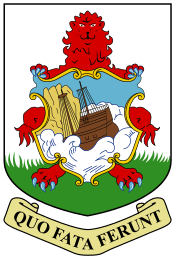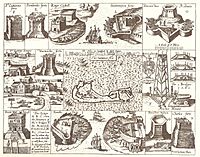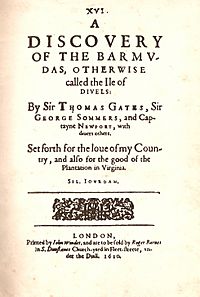Sea Venture facts for kids

The coat of arms of Bermuda features a representation of the Sea Venture wreck.
|
|
| History | |
|---|---|
| Cost | £1,500 |
| Launched | 1609 |
| General characteristics | |
| Tonnage | 300 tonnes |
| Armament |
|
The Sea Venture was an English sailing ship from the 1600s. It was part of a big mission to bring supplies and people to the Jamestown Colony in Virginia. In 1609, the ship was caught in a terrible storm and wrecked in Bermuda.
This ship was special because it was built just for carrying people. It weighed 300 tons and was the main ship for the London Company. Many people believe that the story of the Sea Venture's wreck inspired William Shakespeare's famous play, The Tempest.
Contents
The Virginia Company: Starting a Colony
The London Company started the Jamestown settlement in Virginia in 1607. They sent supplies and more settlers in 1608. Even with new people, the colony faced many problems. There was not enough food, diseases spread, and there were conflicts with local native groups.
The colony at Jamestown was struggling. It seemed like it might fail, just like earlier English attempts to settle in North America. The investors of the London Company wanted to see results from their money. They asked the Jamestown leaders to send back valuable goods. They also wanted gold and news about finding the Pacific Ocean.
Captain John Smith, a leader in Jamestown, sent a very honest reply. He told the investors they needed to send skilled workers, not just more people. He wrote that they needed carpenters, farmers, and blacksmiths. Smith explained that without these skills, most new settlers would not survive. The London Company listened to Smith's message. They planned a much bigger and better-equipped mission. This mission included the new ship, Sea Venture, led by Captain Christopher Newport.
Building the Sea Venture
The London Company built the Sea Venture to be the first ship designed specifically for carrying settlers. It was probably built in Aldeburgh, England. The ship cost £1,500 and weighed 300 tons.
The Sea Venture was different from other ships of its time. Its cannons were on the main deck, not below. This design meant the ship did not need extra layers of wood for strength. It might have been the first armed merchant ship built this way in England. The ship's cargo area was prepared to hold passengers.
The ship carried several cannons:
- Eight 9-pounder demi-culverins
- Eight 5-pounder sakers
- Four 3-pounder falcons
- Four arquebuses (a type of gun)
The Sea Venture was launched in 1609. Its journey to Jamestown was its very first voyage.
The Shipwreck of the Sea Venture
On June 2, 1609, the Sea Venture left Plymouth, England. It was the main ship in a fleet of seven ships. They were carrying 500 to 600 people to Jamestown, Virginia. Usually, ships sailing to North America went south to the Canary Islands to catch good winds. But this fleet sailed north to avoid Spanish ships.
Days away from Jamestown, on July 24, the fleet hit a powerful storm. It was likely a hurricane. The ships got separated. One small ship, the Catch, sank, and everyone on board was lost. The Sea Venture battled the storm for three days.
Because the Sea Venture was new, its wooden parts had not fully settled. Water began to leak quickly into the ship. Everyone worked hard to pump out the water, but it kept rising. The crew even threw some cannons overboard to make the ship lighter.
Sir George Somers, the Admiral of the Company, steered the ship through the storm. On the morning of July 25, he saw land. The ship was full of water, and the people were exhausted. Somers purposely steered the ship onto the reefs of Discovery Bay in Bermuda. This saved the ship from sinking completely. All 150 people and one dog on board made it safely to shore.
The survivors, including important officials like Sir Thomas Gates and Captain Christopher Newport, were stranded on Bermuda for about nine months.
Building New Ships: Deliverance and Patience
Some settlers did not want to leave Bermuda. They had heard how bad conditions were in Jamestown. They tried to rebel, saying the shipwreck meant their contracts were no longer valid. Governor Gates stopped these attempts. The survivors were forced to build new ships to continue their journey.
During their time on Bermuda, the survivors built two new small ships called Deliverance and Patience. They used local Bermuda cedar wood. This wood was strong like oak but lighter. It was also resistant to rot and worms. They also used parts salvaged from the wrecked Sea Venture, especially its ropes and sails.
Admiral Somers and James Davis, a skilled shipbuilder, guided the construction. The Deliverance was built first, but they soon realized it was not big enough. So, they built the Patience as well.
Before the new ships were finished, the Sea Venture's longboat was sent to find Virginia. It was never seen again. Finally, on May 11, 1610, the Deliverance and Patience set sail for Virginia. They carried 142 survivors and arrived at Jamestown on May 23.
Jamestown's Struggles and Bermuda's First Settlers
When they reached Jamestown, they found only 60 survivors out of about 500 people who had arrived earlier. Many of these survivors were dying. Jamestown seemed like it would fail. Everyone decided to leave and sail back to England.
However, another relief fleet arrived just in time. This fleet was led by Governor Baron De La Warre. He brought more supplies and a doctor. He ordered everyone to return to Jamestown.
There was still a severe food shortage. In the fall of 1610, Admiral Somers returned to Bermuda in the Patience to get more food. Sadly, Somers died in Bermuda. His nephew sailed the Patience back to England with his body.
Two sailors, Christopher Carter and Edward Waters, chose to stay behind in Bermuda. They became the first permanent settlers of Bermuda. Later, Edward Chard joined them.
Even with new supplies, 80% of the colonists died during the "Starving Time" of 1610. The arrival of Lord De La Warre saved Jamestown from being completely abandoned.
The Wreck Site of the Sea Venture

The Sea Venture stayed on the reefs off Gate's Bay for a long time. Its crew, passengers, and later settlers took all the useful parts from it. Eventually, what was left of the ship sank beneath the waves.
In 1612, two of its cannons were saved. They were used to build the first forts in Bermuda. One cannon went to Governor's Island, and the other to Castle Island.
The exact location of the wreck was unknown for many years. In October 1958, sport divers Downing and Heird rediscovered it. There was not much left of the ship or its cargo. However, it was positively identified in 1959, just in time for the 350th anniversary of the shipwreck. Later searches found one cannon, cannonballs, and small arms shot. They also found Spanish jars, German stoneware, and cooking pots, similar to items found at Jamestown.
The Sea Venture in Books and Plays
- The wreck of the Sea Venture is widely believed to have inspired William Shakespeare's play The Tempest. This idea is supported by comparing the play to stories from survivors, like the one written by William Strachey.
- Washington Irving wrote a story called The Three Kings Of Bermuda & Their Treasure Of Ambergris in 1840.
- F. Van Wyck Mason, a novelist from Bermuda, wrote a fictional story about the wreck called The Sea 'Venture in 1961.
- Scott O'Dell, an American author, wrote a fictional account of the shipwreck called The Serpent Never Sleeps.
- Children's author Clyde Robert Bulla wrote A Lion to Guard Us. This book tells a fictional story about three children sailing on the Sea Venture to find their father in Jamestown.
- The Sea Venture also gave its name to a cruise liner in the 1970s. This ship later became the Pacific Princess, which was used in the TV show The Love Boat.
Images for kids
-
Captain John Smith's 1624 map of the Somers Isles (Bermuda), showing St. George's Town and related fortifications, including the Castle Islands Fortifications.





